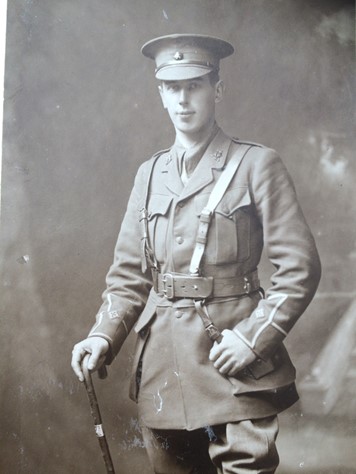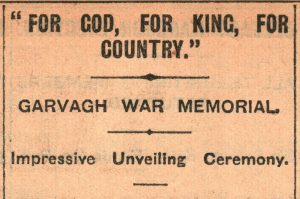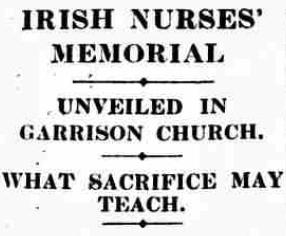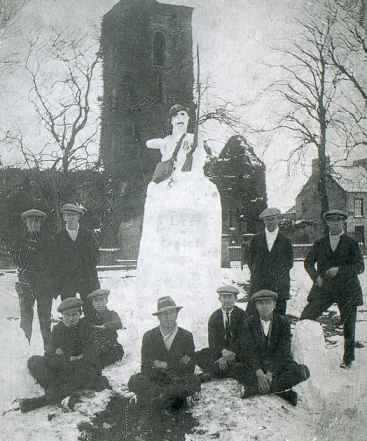 On this day in 1916 Lieutenant Edward Workman died in the Duchess of Westminster hospital, Le Touquet, France where he was being treated for wounds received exactly one week before in a raid on German trenches; it initially was thought that his wounds were not serious.
On this day in 1916 Lieutenant Edward Workman died in the Duchess of Westminster hospital, Le Touquet, France where he was being treated for wounds received exactly one week before in a raid on German trenches; it initially was thought that his wounds were not serious.
Edward (Ted) Workman was born at 32 College Gardens, Belfast on 4th August 1886 into a family of substantial means – the only son of Frank Workman, one of the founders of Workman Clark, Shipbuilders, Belfast and Sara (nee McCausland). He had a younger sister – Florence “Sis” and was educated initially at private school in Walmer, Kent and then went on to Charterhouse and Trinity College, Cambridge. By his early twenties, Ted was a Director of Workman Clark, managing the South Yard of the family’s shipbuilding business and as such was clearly destined for greater things. At the time of the “Home Rule” crisis he was a well-regarded Company Commander in the 6th Battalion, East Belfast Regiment of the Ulster Volunteer Force (UVF) which he had joined from the outset.
At the very outbreak of the Great War Ted volunteered to fight for his country and was gazetted Second Lieutenant, 5th Battalion, The Royal Irish Rifles (Royal South Downs) on 15th August 1914 initially serving at Victoria Barracks, Belfast before posting to the British Expeditionary Force, attached initially, to The York and Lancaster Regiment. He arrived in Rouen, France on 7th May 1915 and was promoted to Lieutenant on 22nd May 1915, attached to the 2nd Battalion RIR. Ted’s first real action was in Belgium at Hooge which is just outside Ypres and close to the perhaps better known Paeschaendael. The action in this theatre was brutal in the extreme and resulted in very high casualties on both sides, many of these inflicted in terrible hand-to-hand fighting in mud and water-filled trenches where men even struggled to pass each other. As an illustration of how terrible the fighting was, Ted was only one of three officers who came out of one of the earlier large raids unscathed (one of these was later killed); for his actions he was Mentioned in Dispatches by Sir John French. At this time, Ted was five feet seven and three quarters inches tall, weighed only 9 stones 13 pounds and the life expectancy of a young front-line officer was known to be measured in days.
In mid-January 1916 an order was issued to conduct a substantial raid on the enemy trenches to capture prisoners and gather information on the enemy’s strength and positions. On 19th January 1916 whilst commanding B Company of the 2nd RIR, he was tasked with leading part of the raid on the enemy trenches at the River Lys near Armentiers. Under heavy rifle, machine gun and artillery fire Ted and his men made it into the German trench and captured a number of prisoners. Whilst holding these prisoners at pistol point and still in the german trenches, he was struck on the head by a rifle butt and was knocked to the ground but recovered sufficiently well to be able to lead his men and prisoners back to their own trenches. Following treatment at the First Aid Station he was evacuated to the Duchess of Westminster’s Hospital at Le Touquet, Sadly, and despite the best efforts of the surgeons, he developed a severe infection which was to lead to his death from meningitis exactly one week after receiving his injury. Perhaps uniquely, his Father, Mother, Sister and her husband had travelled to France in time to see the seriously ill Ted. He was laid to rest in a simple military ceremony in the Camiers Road Military Cemetery at Etaples in France and in recognition of his significant part in the action and for his courage under fire he was awarded (posthumously) the Military Cross.
Frank and Sara paid tribute to their beloved son by erecting a memorial commemorating Ted and 135 Workman Clark employees who died in that war. They commissioned Sophia Rosamund Praeger to carve three relief panels and a silhouette of Ted, the latter forming the centrepiece of the memorial. The remaining portions of the original memorial – the carved silhouette of Edward Workman, the panel detailing Ted’s civil and military accomplishments, and the panels listing the names of the shipyard fatalities are embedded in the outer wall of the Pumphouse building at the Thompson Dock in Belfast’s Titanic Quarter.
As her own tribute to her beloved son, Sara compiled a substantial archive which contains a mixture of family photographs and articles chronicling Ted’s short life. Included in this are many of his letters from the Front including a barely legible scribbled note from him written from the hospital only a few days before he died. This important archive is a treasured family possession.

 In the Preface to the book, Gavin says,
In the Preface to the book, Gavin says,

